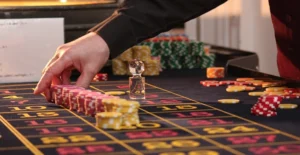Planning a poker night with friends can be a lot of fun, especially when you’re keeping the buy-ins low. I’ve found that a $20 buy-in is a sweet spot for casual home games – it’s affordable for most people, but still gives everyone enough chips to play with for a while. The trick, though, is getting the chip distribution right. It’s not just about handing out chips; it’s about making sure the game flows smoothly and everyone feels like they have a fair shot. I’ve learned a few things about how to set up the $20 buy-in poker chip distribution so the game doesn’t get bogged down with constant chip changes or confusion.
Key Takeaways
- For a $20 buy-in, playing with blinds like $0.05/$0.10 gives players a 200 big blind stack, which is a good starting point for a cash game.
- Using three or four chip colors is usually enough for a $20 buy-in game, with lower denominations being the most common.
- A practical chip breakdown for a $20 buy-in might look like 40 chips of $0.05, 40 chips of $0.10, 40 chips of $0.25, and 6 chips of $1.
- It’s better to have more chips than you think you’ll need, just in case the game gets popular or players want to rebuy.
- When choosing chip colors, stick to common casino colors like white for $1, red for $5, and green for $25 to avoid confusion.
Choosing the Right Stakes for a $20 Buy-In
When I set up a home poker game with a $20 buy-in, the first thing I consider is the stakes. For this buy-in amount, I’ve found that playing with blinds of $0.05/$0.10 works well. This gives everyone a stack of 200 big blinds, which is a pretty standard and comfortable starting point for a cash game. It allows for some decent play without the stacks getting too shallow too quickly.
With $0.05/$0.10 blinds, you’ll need a few different chip denominations to make the game run smoothly. I usually go with chips in values of $0.05, $0.25, and $1. This mix lets players make all the necessary bets and raises without having to count out a huge number of small chips. For a $20 buy-in, a good starting breakdown per player might look something like this:
- $0.05 chips: 20 chips (totaling $1)
- $0.25 chips: 32 chips (totaling $8)
- $1 chips: 11 chips (totaling $11)
This gives each player a total of $20 to start with. It’s important to have enough chips so that players don’t run out too quickly, especially if they’re playing a bit more aggressively. You want to avoid situations where someone has to break a larger chip just to call a small bet.
It’s always better to have a few extra chips on hand than not enough. If your game becomes popular, you’ll be glad you bought a set with plenty of denominations and quantities. This way, you won’t have to scramble to get more chips before the next game.
If you’re looking to adjust the distribution slightly, you could swap out some of the $1 chips for more $0.05 or $0.10 chips. For instance, you might give each player 40 of the $0.05 chips and 40 of the $0.10 chips, along with fewer $0.25 and $1 chips. This can make betting feel even more fluid, especially in the early stages of the game. Just remember to keep the total buy-in at $20. Thinking about how players will interact with the chips, much like managing your stack in a blackjack tournament, is key to a good experience.Managing your chip stack
Selecting Appropriate Chip Denominations
When I’m setting up a home poker game, especially with a $20 buy-in, figuring out the chip denominations is important. You don’t want players fumbling around trying to make change for a simple bet. The goal is to have a mix of chips that makes betting easy and covers all the likely amounts.
For a $20 buy-in, I usually aim for a stack that feels substantial but also allows for some maneuvering. A common approach is to give each player around 100 chips to start. This makes the blinds feel meaningful without eating up stacks too quickly. Here’s a breakdown I often use:
- 25 White chips ($1 value): These are your workhorses for small bets and making change.
- 20 Red chips ($5 value): Good for larger bets and blinds.
- 4 Green chips ($25 value): These are for the bigger bets and help keep the stacks from getting too bulky.
This gives a starting stack of $100 (25*$1 + 20*$5 + 4*$25 = $25 + $100 + $100 = $225). Wait, that’s not right. Let me re-calculate. Okay, so 25 white chips at $1 each is $25. Then 20 red chips at $5 each is $100. And 4 green chips at $25 each is $100. That totals $225. That’s way too much for a $20 buy-in. My mistake. Let’s try again.
For a $20 buy-in, we need to be more careful. A better distribution might be:
- 20 White chips ($1 value): $20 total.
- 10 Red chips ($5 value): $50 total.
- 2 Green chips ($25 value): $50 total.
This gives a starting stack of $120 (20*$1 + 10*$5 + 2*$25 = $20 + $50 + $50 = $120). This feels more appropriate for a $20 buy-in, giving players plenty of chips to work with. It’s important to have enough low-value chips so players can make small bets without breaking their bigger chips too early. You can find good chip sets online that offer a variety of colors and values, which helps organize the game.
The key is to have denominations that allow players to easily represent common bet sizes, like the small blind, big blind, and raises, without needing to exchange chips constantly. Having too many high-value chips at the start can make the game feel slow, while too many low-value chips can lead to bulky stacks and confusion.
I also consider the blinds. If the blinds are $1/$2, then having $1 and $5 chips is a must. If the blinds go up to $5/$10, you’ll definitely need $25 chips. It’s all about making the betting flow naturally. You want players to be able to bet the blinds and make raises without having to count out a dozen small chips every time. It makes a difference in how smoothly the game runs.
Determining the Optimal Chip Breakdown per Player
Alright, so you’ve got your $20 buy-in set, and now it’s time to figure out what each player actually gets in their hands. This is where things get a little more specific, and honestly, it makes a big difference in how the game feels. You don’t want players running out of chips after just a few hands, or having stacks so big they’re impossible to manage.
For a $20 buy-in, I usually aim for a starting stack that feels substantial enough to play a few hands without immediately going broke. A good rule of thumb is to give players around 25 to 40 chips to start. This means for a game with, say, 6 to 8 players, you’re looking at needing somewhere between 150 and 320 chips in total. It’s all about balancing the number of chips per person to keep the game moving at a good pace.
Here’s a breakdown that often works well for a $20 buy-in:
- 12 chips of the lowest denomination (e.g., $0.25)
- 12 chips of the next denomination (e.g., $1)
- 1 chip of a higher denomination (e.g., $5)
This gives each player a starting stack of 25 chips, totaling $20. It’s a simple mix that allows for small bets early on and provides a bit of a cushion. You can adjust these numbers slightly, maybe adding an extra $1 chip or two if you want slightly deeper starting stacks. The key is to have enough of the low-value chips so players can actually make bets without having to use their higher-value chips too early. It’s also helpful to have a few of the higher chips so players can make change if someone needs to rebuy.
When you’re handing out chips, try to make it as straightforward as possible. Nobody wants to spend five minutes counting out their starting stack. A clean, consistent distribution makes everyone feel like the game is well-organized from the get-go. It sets a good tone for the whole night.
Remember, the goal is to make the game playable and fun. Having too many of one denomination or not enough of another can mess with the flow. You want players to be able to bet comfortably, and that means having the right mix in their hands. You can find some great poker chip sets online that come with pre-determined distributions, which can be a real time-saver if you’re just starting with hosting games. Check out options for poker chip sets to see what fits your needs.
Calculating Total Chips Needed for the Game
Alright, so you’ve figured out the chip denominations and how many of each a single player gets for their $20 buy-in. Now comes the part where we figure out the grand total of chips we’ll need for everyone at the table. This is straightforward math, but it’s important to get it right so you don’t run out of chips mid-game.
First, you need to know exactly how many players are expected. Let’s say you’re hosting a game for 8 people, and each person gets the following stack:
- 12 x $0.25 chips
- 12 x $1 chips
- 1 x $5 chip
To calculate the total number of each chip denomination needed, you just multiply the amount per player by the number of players. So, for 8 players:
- $0.25 chips: 12 chips/player * 8 players = 96 chips
- $1 chips: 12 chips/player * 8 players = 96 chips
- $5 chips: 1 chip/player * 8 players = 8 chips
It’s always a good idea to have a few extra chips of each denomination on hand, just in case. Maybe add 10-20% extra to your calculated totals. This covers any potential mistakes in distribution or if someone needs to make a quick change. For our 8-player example, I’d probably grab around 10-12 of the $0.25 and $1 chips, and maybe 2-3 of the $5 chips, just to be safe. This ensures you have enough for the initial buy-ins and any early rebuys without scrambling.
Having a surplus of chips means you won’t have to worry about running out during critical hands. It’s better to have a few extras than to be short when someone wants to rebuy or add on.
Remember, for a casual Texas Hold’em game with 6-8 players, around 300 poker chips are usually enough, particularly if you don’t need to replicate deep-stacked play. This calculation helps you determine the specific quantities of each color you’ll need from your set. You can check out some common chip sets to get an idea of what’s available and how they might fit your needs for a casual game.
So, for our 8-player game, I’d aim to have at least 100 of the $0.25 and $1 chips, and about 10-12 of the $5 chips. This gives you a little buffer. If you have a chip set with many more denominations, you’ll just repeat this multiplication process for each chip value each player receives.
Preparing for Rebuys and Late Entries
When I host a poker game, especially with a $20 buy-in, I always think about how to handle players who want to jump in later or need to add more chips. It keeps the game lively and fair for everyone. It’s best to have a plan for rebuys and late entries before the first hand is even dealt.
Here’s how I usually approach it:
- Define the Rebuy Period: I typically allow rebuys for the first hour or so of play, or until the blinds get high. This gives people a chance to get back in if they bust early or if they were running late.
- Set Rebuy Amounts: For a $20 buy-in game, I usually let players rebuy for another $20. This keeps the chip stacks consistent with the initial buy-in, making things simpler.
- Late Entry Policy: If someone shows up late, I let them buy in for the standard $20 as long as the rebuy period is still open. If they arrive after the rebuy period closes, they can still join, but they can’t rebuy if they get knocked out. They just get the standard starting stack.
To make sure I have enough chips, I usually prepare a few extra starting stacks. For a $20 buy-in, a common starting stack might look something like this:
| Chip Color | Value | Number of Chips |
| White | $1 | 10 |
| Blue | $5 | 2 |
| Red | $25 | 1 |
This gives a total of $45 in chips, which is a bit more than the $20 buy-in. This is because we’re using lower denominations to make betting easier, especially in the early stages. So, for a $20 buy-in, I’d give out 10 white chips ($10) and 2 blue chips ($10), totaling $20. The red $25 chip is usually held back for rebuys or for players who want to add on.
Having a clear system for rebuys and late entries prevents confusion and keeps the game moving smoothly. It’s about making sure everyone feels welcome and has a fair shot at winning, no matter when they join.
If a player busts and wants to rebuy, I’ll give them the same starting stack as everyone else. If they’re joining late, they get the starting stack too, as long as it’s within the allowed time frame. This way, everyone starts with a comparable amount of chips, and the game stays balanced.
Setting Up the Table and Seating Arrangements
Getting the table ready and figuring out where everyone sits is more important than you might think. It sets the tone for the whole night. I usually try to pick a table that’s big enough for everyone to be comfortable, with enough space for their chips and drinks. Having a good poker table, maybe one designed for around 8 people, makes a big difference. It’s nice when the surface is padded and easy to clean, too.
When it comes to seating, I like to mix things up a bit. Sometimes I’ll just let people pick their seats, but other times, especially if I know the group well, I might suggest a seating arrangement. The goal is to create a good mix of players and avoid having too many strong players sitting next to each other, which can sometimes make the game a bit predictable. It’s also a good idea to consider who might be a bit more talkative or quiet and place them accordingly to keep the conversation flowing, but not overwhelming.
Here’s a simple way I often think about distributing chips once everyone is seated:
- Low Denominations: Give out a good amount of the smallest chips. For a $20 buy-in, I’d probably start with a lot of $1 chips, maybe 10-15 per player.
- Mid-Range Chips: Add in a decent number of $5 chips. These are great for making bets and blinds.
- High Denominations: Include just a few of the higher value chips, like $20s or $25s, depending on your chip set. These are for bigger pots or later in the game.
For a $20 buy-in, a common starting stack might look something like this:
| Chip Value | Quantity | Total Value |
| $1 | 12 | $12 |
| $5 | 2 | $10 |
| $20 | 1 | $20 |
This gives a total buy-in of $42, which is a bit more than the $20, but it’s a common way to distribute chips to make play easier. You can adjust this based on your specific chipset and how many players you have. The key is to have enough small chips for the early game and enough flexibility for later betting.
It’s always a good idea to have a few extra chips on hand, just in case. Sometimes players want to rebuy, or maybe you miscalculated the initial distribution. Having a small reserve of each denomination can save you from having to dig through a big box of chips mid-game.
Remember, the setup is part of the fun. A well-organized table and thoughtful seating can make the difference between a casual game and a memorable one. It’s about making sure everyone feels comfortable and ready to play. If you’re looking for a good table, there are some great options for friendly games that can fit your needs.
A well-organized setup contributes to a more enjoyable gaming experience.
When I host poker nights, I’ve found that a little bit of prep work goes a long way. It’s not just about the chips themselves, but how everything is laid out. A tidy table makes it easier for everyone to see their chips, track bets, and generally just focus on the game without fumbling around.
I usually start by making sure I have enough chips for everyone, plus a few extra for rebuys. Then, I sort them by denomination. It sounds simple, but having them organized makes handing them out a breeze.
Here’s a quick way I like to set up the chip distribution for a $20 buy-in game:
- Low Denomination Chips: These are your workhorses. I usually give out a good chunk of these, maybe 10-15 chips per player, to cover blinds and small bets. Think of $1 or $5 chips.
- Mid-Range Chips: A few of these are good for building pots or making larger bets. I might give out 3-5 of these, like $10 or $25 chips.
- High Denomination Chips: You might only need one or two of these, if any, for a $20 buy-in. These are for the big bets later in the game. Maybe a $100 chip.
The goal is to have enough chips so players don’t have to constantly color up, which can slow things down. You want players to be able to make bets without running out of the right chips too quickly.
Having a clear stack for each player, with the chips sorted, helps. It prevents confusion and makes the game feel more professional, even if it’s just a casual home game. Plus, it just looks nicer when everything is neat.
Establishing Clear House Rules
Setting down some ground rules before the cards start flying is important, I’ve found. It helps avoid any awkward moments or arguments later on. Think of it like laying the foundation for a good game night.
For a $20 buy-in game, I usually start with a few key points:
- Buy-in Amount: Everyone contributes $20 to get their starting stack. This is straightforward.
- Starting Stack: We’ll distribute chips so everyone gets the same amount. This keeps things fair from the get-go. For a $20 buy-in, a common setup might be 20 chips of $1 value and 10 chips of $0.50 value, or perhaps 10 chips of $1 and 10 chips of $1.50. The exact breakdown depends on the denominations you have available, but the total value should equal $20.
- Rebuys: Decide if players can buy back in if they lose all their chips. If so, how many times? And what’s the rebuy amount? Usually, it’s the same $20 buy-in. I like to allow rebuys for the first hour of play, but that’s just my preference.
- Add-ons: Some games offer an add-on at a certain point, usually when rebuys stop. This is an optional extra purchase for a set amount of chips. It can add a bit of spice to the game.
- Betting Structure: Will it be no-limit, pot-limit, or fixed-limit? For casual home games, no-limit is often the most popular. We also need to set the blinds and antes. For a $20 buy-in, starting blinds of $0.25/$0.50 or $0.50/$1 are common. You can find good starting points for blinds in guides on No-Limit Hold’em.
- Showdown Rules: What happens when two or more players go to showdown? Who shows their cards first? Generally, the player who made the last aggressive action (bet or raise) shows first.
- Dealer Button: How does the button move? It typically moves one seat to the left after each hand.
It’s a good idea to write these rules down on a small piece of paper or a whiteboard so everyone can see them. This way, there’s no confusion, and everyone’s on the same page.
We also need to agree on how chips are handled. For instance, if someone needs to break a larger chip for a smaller bet, they should be able to do that easily. If a player runs out of a certain chip value, they can exchange it with the dealer or another player, as long as it’s done openly. This keeps the game moving smoothly and prevents any hold-ups.
Managing the Game Flow and Pacing
Keeping the game moving at a good clip is key to everyone having fun. It’s not just about the cards; it’s about how smoothly everything runs. When chips are distributed well, it helps with this. If players have the right mix of chip values, they won’t be fumbling around trying to make change for every bet. This means less downtime between hands and more actual poker being played.
Think about it: if someone needs to bet $15 and only has $25 chips, they have to ask for change. That slows things down. Having plenty of $1 and $5 chips, especially early on, makes those smaller bets and raises easy. As the game progresses and blinds go up, players will naturally start using their higher-value chips more. It’s a natural progression that keeps the game flowing.
Here’s a quick way to think about chip management during play:
- Keep smaller chips accessible: Make sure players can easily get smaller denominations if they need them, perhaps by having a small reserve with the host or allowing players to swap with each other.
- Encourage clear betting: Players should announce their bets clearly and place their chips in a way that’s easy for everyone to see.
- Don’t hoard chips: While it’s good to have a solid stack, constantly fiddling with your chips or making overly complex chip-sorting maneuvers can be a distraction. Keep it simple.
A well-organized chip setup isn’t just about looks; it directly impacts how quickly and smoothly the game progresses. When players aren’t held up by chip issues, the overall pace picks up, leading to more hands played and a more engaging experience for everyone at the table. It’s a small detail that makes a big difference.
If you notice the game is dragging, it might be worth a quick check to see if chip distribution is the culprit. Sometimes a simple chip swap can get things back on track. Ultimately, a good host keeps an eye on these things and makes adjustments as needed to keep the energy up and the game enjoyable.
Frequently Asked Questions
What are the best stakes to play for a $20 buy-in game?
For a $20 buy-in, I find that playing with blinds of $0.05/$0.10 works very well. This setup gives each player a stack of 200 big blinds, which is a common and comfortable amount for cash games. It lets players make plenty of bets and plays without running out of chips too quickly.
How many different chip colors do I need for a $20 buy-in game?
To manage a $20 buy-in game effectively with $0.05/$0.10 stakes, I usually suggest using at least three different chip colors. This allows for a good mix of small and larger chip values, making it easier for players to bet and manage their stacks throughout the game.
What’s a good chip breakdown for a $20 buy-in?
A solid breakdown I often use is something like 20 chips worth $0.05, 32 chips worth $0.25, and 11 chips worth $1. This gives each player a total value of $20 and provides enough smaller chips for betting and larger ones for bigger pots. Some people like to add $0.10 chips too, which can make betting even smoother.
Should I buy more chips than I think I’ll need?
Yes, I always recommend buying a chip set that has more chips than you think you’ll need right from the start. Home games can become very popular, and it’s much better to have too many chips than to run out during a game. It saves you from having to scramble for more later on.
How should I handle rebuys or new players joining late?
For rebuys or players joining late, I make sure to have a few extra sets of the starting chip distribution ready. This way, anyone who wants to buy back in or join the game can get the same starting stack as everyone else, keeping things fair and easy to manage.
What’s the most important thing to remember when setting up chips?
The most crucial thing, in my experience, is to make sure the chip distribution makes sense for the game you’re playing. You want betting to feel natural, not awkward. Having stacks that are easy to count and use, with clear values, helps everyone enjoy the game more. It’s about making the game flow smoothly.
Daniel Chase is a seasoned casino analyst and iGaming writer with over 10 years of experience in the online gambling industry. He specializes in game strategy, casino odds, and player-focused reviews. Daniel is passionate about helping players make smarter decisions through transparency, real data, and honest insight.











